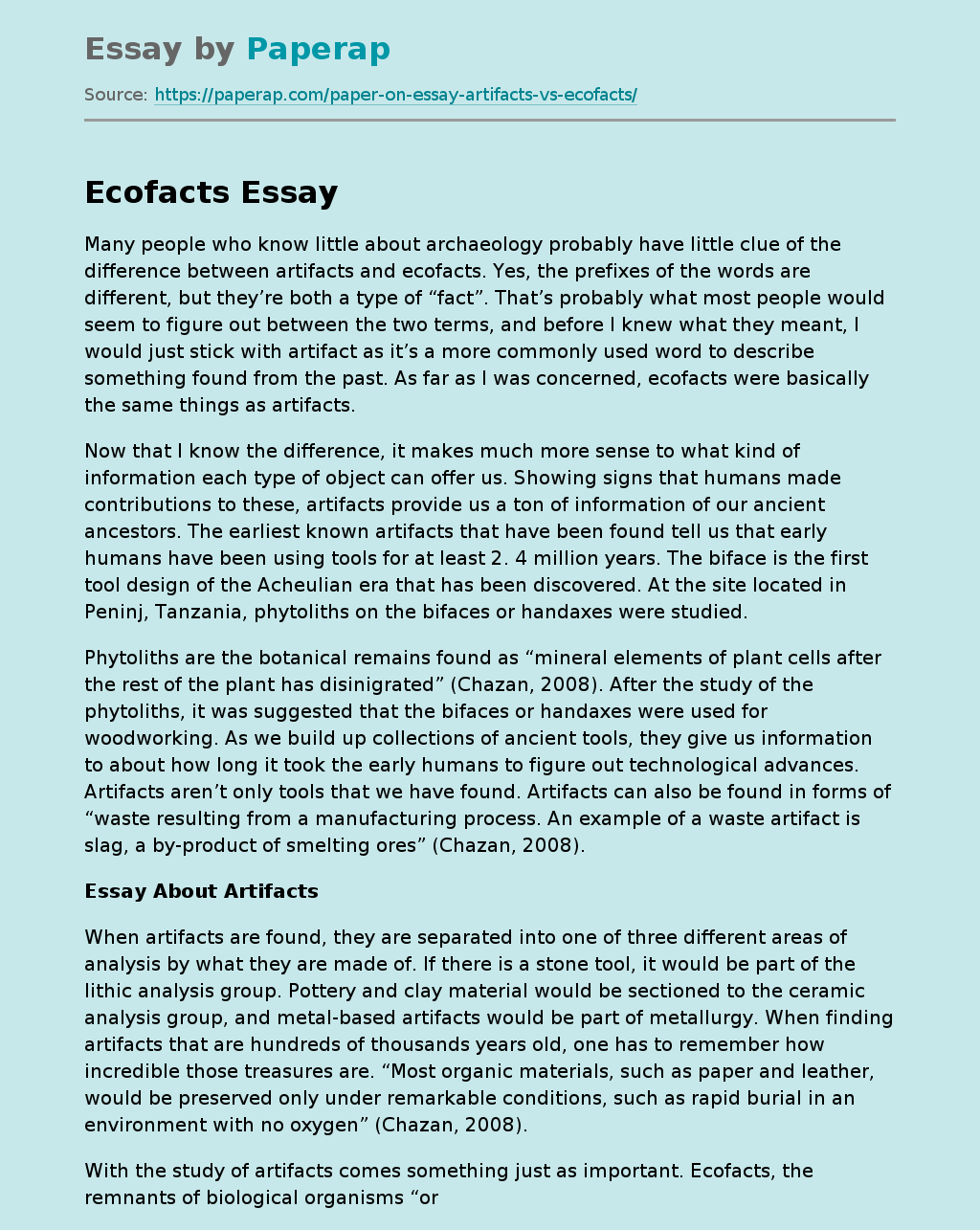Essay About Artifacts
Many people who know little about archaeology probably have little clue of the difference between artifacts and ecofacts. Yes, the prefixes of the words are different, but they’re both a type of “fact”. That’s probably what most people would seem to figure out between the two terms, and before I knew what they meant, I would just stick with artifact as it’s a more commonly used word to describe something found from the past. As far as I was concerned, ecofacts were basically the same things as artifacts.
Now that I know the difference, it makes much more sense to what kind of information each type of object can offer us. Showing signs that humans made contributions to these, artifacts provide us a ton of information of our ancient ancestors. The earliest known artifacts that have been found tell us that early humans have been using tools for at least 2. 4 million years. The biface is the first tool design of the Acheulian era that has been discovered.
At the site located in Peninj, Tanzania, phytoliths on the bifaces or handaxes were studied.
Phytoliths are the botanical remains found as “mineral elements of plant cells after the rest of the plant has disinigrated” (Chazan, 2008). After the study of the phytoliths, it was suggested that the bifaces or handaxes were used for woodworking. As we build up collections of ancient tools, they give us information to about how long it took the early humans to figure out technological advances. Artifacts aren’t only tools that we have found.
Artifacts can also be found in forms of “waste resulting from a manufacturing process. An example of a waste artifact is slag, a by-product of smelting ores” (Chazan, 2008).
When artifacts are found, they are separated into one of three different areas of analysis by what they are made of. If there is a stone tool, it would be part of the lithic analysis group. Pottery and clay material would be sectioned to the ceramic analysis group, and metal-based artifacts would be part of metallurgy. When finding artifacts that are hundreds of thousands years old, one has to remember how incredible those treasures are. “Most organic materials, such as paper and leather, would be preserved only under remarkable conditions, such as rapid burial in an environment with no oxygen” (Chazan, 2008).
With the study of artifacts comes something just as important. Ecofacts, the remnants of biological organisms “or the results of geological processes” (Chazan, 2008) can give us as much, if not more information of the past. Without ecofacts present, a lot of information from artifacts would be invaluable. For example, without the phytoliths found on the bifaces, archaeologists wouldn’t have known what they were exactly used for. Ecofacts, like artifacts, also have their own specific areas of analysis.
There’s the faunal analysis which is specifically the study of animal bones, paleoethnobotany which is the study of plant remains like the phytoliths on the bifaces, and then there is human osteoarchaeology which specifies in “the study of the biological characteristics of human skeletal material recovered on archaeological excavations” (Chazan, 2008). Being able to analyze ear stones, or otoliths of fish that are smaller than my thumbnail is amazing. Having information like that accessible to us modern humans is awesome because we don’t have to theorize everything.
It’s insane what type of information we can discover through the study of ecofacts. It really pushes the theory of evolution ahead of the game with given fact that living things do actually have the ability to evolve. Back in the days of Charles Darwin, evolution was a touchy subject. Now since there is so much information to back his theory, we are able to put more pieces of the puzzle together. There are still going to be many pieces missing, but with the findings of artifacts and ecofacts, theories can turn to proven fact, and misguided teachings can be corrected.
Essay About Artifacts. (2019, Dec 05). Retrieved from https://paperap.com/paper-on-essay-artifacts-vs-ecofacts/

